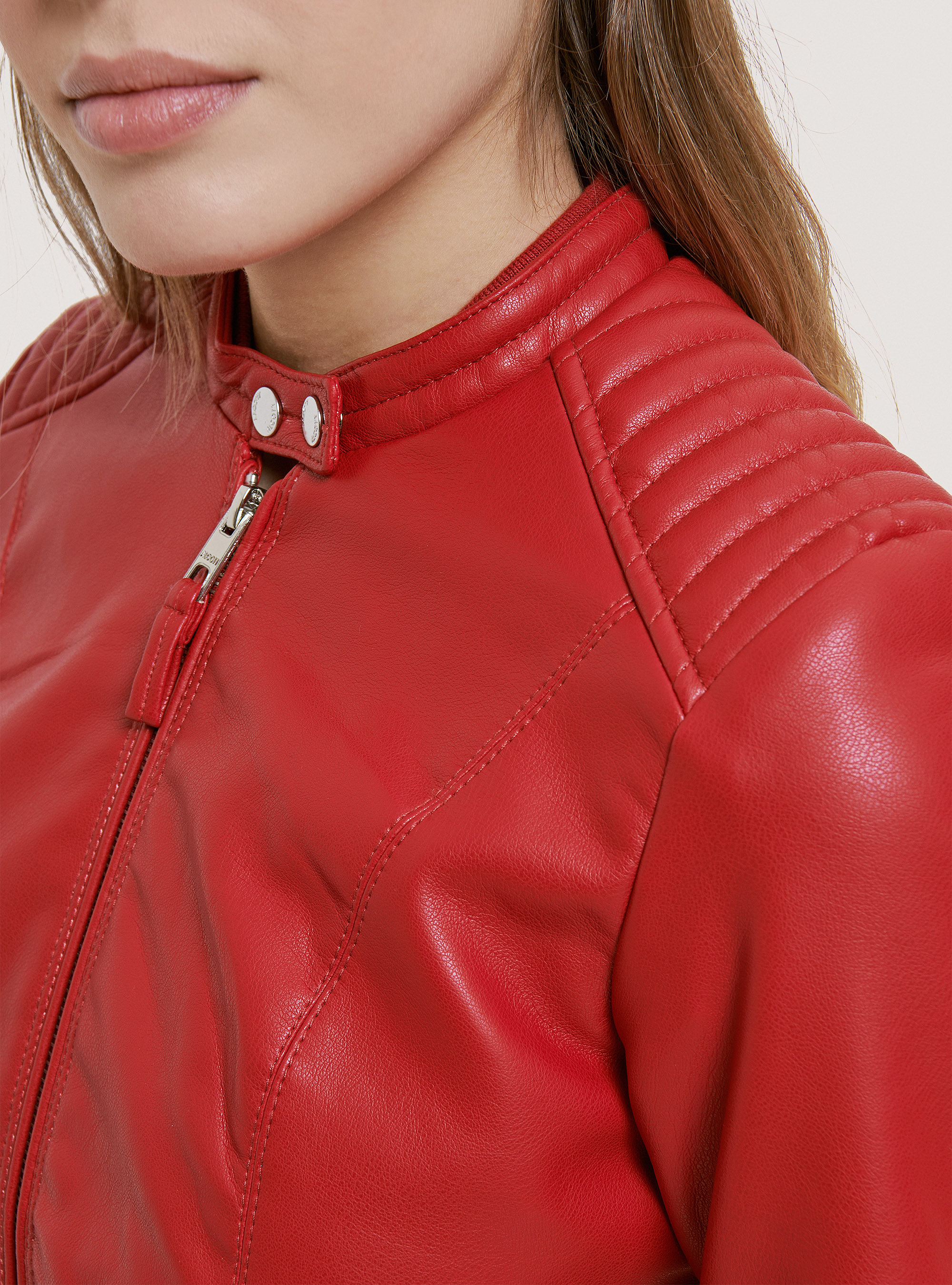Are you noticing your faux leather jacket starting to peel? Don't panic just yet! Faux leather jackets are trendy, stylish, and affordable, but they do come with their own set of challenges. If you're noticing peeling or cracking, you're not alone. Many people struggle with maintaining the look and feel of their faux leather pieces. But don't worry, because we're here to help!
Peeling faux leather can be frustrating, especially if you've invested in a jacket that you absolutely adore. But before you toss it out or write it off as a lost cause, there are plenty of things you can do to fix and prevent further damage. In this article, we’ll dive deep into the world of faux leather jackets, exploring why they peel, how to care for them, and what you can do to extend their lifespan.
Whether you're a fashion enthusiast or simply someone who loves the sleek, modern look of faux leather, this guide will give you all the tools you need to keep your jacket looking as good as new. Let's get started!
- Is Queens Ny Safe The Real Scoop You Need To Know
- Being A Mom Is Not Easy Quotes That Capture The Heart Of Motherhood
Here's a quick rundown of what we'll cover:
- Why Does Faux Leather Peel?
- How to Fix Faux Leather Peeling
- Preventing Further Damage
- Caring for Your Faux Leather Jacket
- Tips for Buying Faux Leather
- Common Mistakes to Avoid
- Alternatives to Faux Leather
- Frequently Asked Questions
- Final Thoughts
Why Does Faux Leather Peel?
Faux leather is made from synthetic materials, usually a combination of polyurethane (PU) or polyvinyl chloride (PVC) coated onto a fabric backing. While it’s designed to mimic the look and feel of real leather, it doesn’t have the same durability. Over time, factors like heat, moisture, and wear and tear can cause the outer layer to start peeling. But what exactly causes this?
Factors That Contribute to Peeling
Here are some common culprits behind faux leather jacket peeling:
- Thank You Quotes For Principal Heartfelt Words To Honor Their Leadership
- What Companies Are In The Consumer Services Field A Deep Dive Into The World Of Consumer Services
- Exposure to Heat: Leaving your jacket in direct sunlight or near a heat source can cause the material to dry out and crack. This is especially true if the jacket isn’t properly conditioned.
- Moisture Damage: Faux leather isn’t as water-resistant as real leather. If your jacket gets wet and isn’t dried properly, it can lead to peeling and discoloration.
- Poor Quality Material: Not all faux leather is created equal. If you’ve purchased a jacket made from low-quality materials, it’s more likely to peel sooner rather than later.
- Improper Care: Using the wrong cleaning products or failing to condition your jacket regularly can accelerate the peeling process.
Understanding these factors is the first step toward preventing and fixing peeling faux leather. Now let’s dive into how you can tackle the issue.
How to Fix Faux Leather Peeling
If your faux leather jacket is already showing signs of peeling, don’t despair! There are several DIY methods and professional treatments you can try to repair the damage.
DIY Fixes for Peeling Faux Leather
Here are some easy fixes you can try at home:
- Leather Repair Kits: These kits usually come with a conditioner, dye, and sealer. They’re perfect for touching up small areas of peeling or discoloration.
- Clear Nail Polish: Believe it or not, clear nail polish can be a quick fix for minor peeling. Simply apply a thin layer over the affected area and let it dry completely.
- Vaseline or Coconut Oil: These natural conditioners can help soften and moisturize faux leather, preventing further peeling.
Remember, while DIY fixes can work wonders for minor issues, they may not be suitable for extensive damage. For more severe cases, it’s best to consult a professional.
Preventing Further Damage
Once you’ve repaired the peeling on your faux leather jacket, it’s important to take steps to prevent further damage. Here are some tips to keep your jacket in top condition:
Protect Your Jacket from the Elements
Extreme temperatures and moisture are two of the biggest enemies of faux leather. To protect your jacket:
- Avoid leaving it in direct sunlight or near heat sources.
- Store it in a cool, dry place when not in use.
- Use a waterproof spray to add an extra layer of protection against moisture.
By taking these precautions, you can significantly extend the lifespan of your jacket.
Caring for Your Faux Leather Jacket
Proper care is key to maintaining the appearance and longevity of your faux leather jacket. Here’s a step-by-step guide to keeping it in great condition:
Cleaning Your Jacket
Regular cleaning helps prevent dirt and grime from building up on your jacket. Follow these steps:
- Use a soft, damp cloth to wipe down the surface of the jacket. Avoid using harsh chemicals or abrasive materials.
- For stubborn stains, mix a small amount of mild soap with water and gently scrub the affected area.
- Rinse the cloth thoroughly and wipe away any soap residue.
Conditioning Your Jacket
Conditioning is essential for keeping faux leather soft and supple. Here’s how to do it:
- Apply a small amount of faux leather conditioner to a soft cloth.
- Gently rub the conditioner into the jacket in circular motions.
- Allow the conditioner to soak in for a few minutes before buffing the jacket with a clean, dry cloth.
Regular conditioning can help prevent peeling and keep your jacket looking fresh.
Tips for Buying Faux Leather
When shopping for a faux leather jacket, it’s important to choose one that’s made from high-quality materials. Here are some tips to help you make the right choice:
Look for PU Leather
PU leather is generally considered to be of higher quality than PVC leather. It’s more durable, breathable, and less likely to peel. When shopping, check the label to see what material the jacket is made from.
Check the Stitching
Good stitching is a sign of quality craftsmanship. Look for jackets with reinforced seams and evenly spaced stitches. This will help ensure that your jacket holds up over time.
Consider the Weight
A heavier jacket is usually a good indicator of quality. Lightweight jackets may be more prone to peeling and other forms of damage.
Common Mistakes to Avoid
Even with the best intentions, it’s easy to make mistakes when caring for faux leather. Here are some common pitfalls to avoid:
Using the Wrong Cleaning Products
Harsh chemicals and abrasive cleaners can damage faux leather, causing it to dry out and peel. Always use products specifically designed for faux leather.
Ignoring Signs of Wear
Small cracks or peeling can quickly turn into bigger problems if left untreated. Address any issues as soon as you notice them to prevent further damage.
Storing Improperly
Hanging your jacket on a hanger or folding it neatly can help prevent creases and folds that may lead to peeling. Avoid stuffing it into a cramped closet or leaving it bunched up in a bag.
Alternatives to Faux Leather
If you’re tired of dealing with peeling faux leather, you might want to consider some alternatives. Here are a few options:
Real Leather
Real leather is more durable and tends to develop a beautiful patina over time. While it’s more expensive, it’s also more sustainable in the long run.
Vegetable-Tanned Leather
This type of leather is made using natural tanning methods, making it a more eco-friendly choice. It’s also less likely to peel or crack compared to synthetic alternatives.
Fabric Jackets
If you’re looking for a completely different material, consider opting for a fabric jacket instead. They’re often more breathable and easier to care for.
Frequently Asked Questions
Here are some common questions people have about faux leather jackets:
Can Faux Leather Be Repaired?
Absolutely! With the right tools and techniques, you can repair minor peeling and damage to your faux leather jacket.
Is Faux Leather Eco-Friendly?
Faux leather is generally considered to be more eco-friendly than real leather, as it doesn’t involve the use of animal products. However, it’s important to choose jackets made from sustainable materials whenever possible.
How Long Do Faux Leather Jackets Last?
With proper care, a high-quality faux leather jacket can last several years. Lower-quality jackets may start to peel or crack after just a few seasons.
Final Thoughts
Faux leather jacket peeling doesn’t have to be the end of the world. By understanding the causes of peeling and taking steps to prevent and repair it, you can keep your jacket looking great for years to come. Remember to choose high-quality materials, care for your jacket properly, and address any issues as soon as they arise.
If you found this article helpful, don’t forget to share it with your friends and family. And if you have any questions or tips of your own, feel free to leave a comment below. Happy styling!



Detail Author:
- Name : Floyd Jenkins
- Username : gleason.kailyn
- Email : yasmeen.hudson@padberg.com
- Birthdate : 1999-02-09
- Address : 7301 Dietrich Fort Kesslerchester, LA 58745-9663
- Phone : 1-513-640-8936
- Company : O'Keefe Group
- Job : Tour Guide
- Bio : Quia sunt ea nisi excepturi atque. Vel assumenda aut inventore blanditiis. Ut recusandae quaerat qui eum voluptas culpa consequatur.
Socials
tiktok:
- url : https://tiktok.com/@viola_doyle
- username : viola_doyle
- bio : Sint aspernatur voluptatem alias reprehenderit quaerat.
- followers : 6259
- following : 94
twitter:
- url : https://twitter.com/viola_doyle
- username : viola_doyle
- bio : Ullam inventore rerum dolorum officiis laboriosam sit. Ut et asperiores rerum at repellendus aut omnis occaecati. Autem et magnam qui sit.
- followers : 2383
- following : 1271
linkedin:
- url : https://linkedin.com/in/viola_xx
- username : viola_xx
- bio : Magnam ut numquam officia et vero dolore.
- followers : 4129
- following : 2044
facebook:
- url : https://facebook.com/viola_xx
- username : viola_xx
- bio : Quae rerum perspiciatis iure eos ab.
- followers : 4934
- following : 102